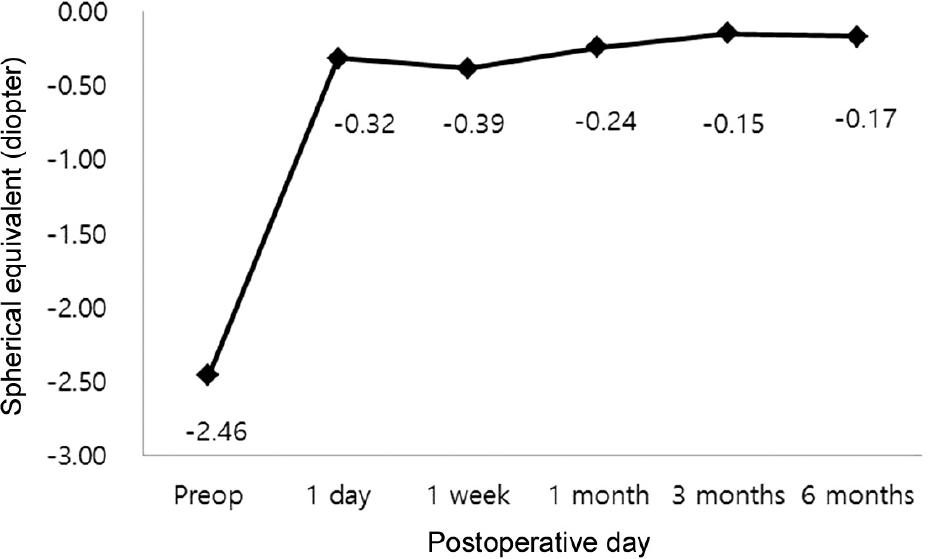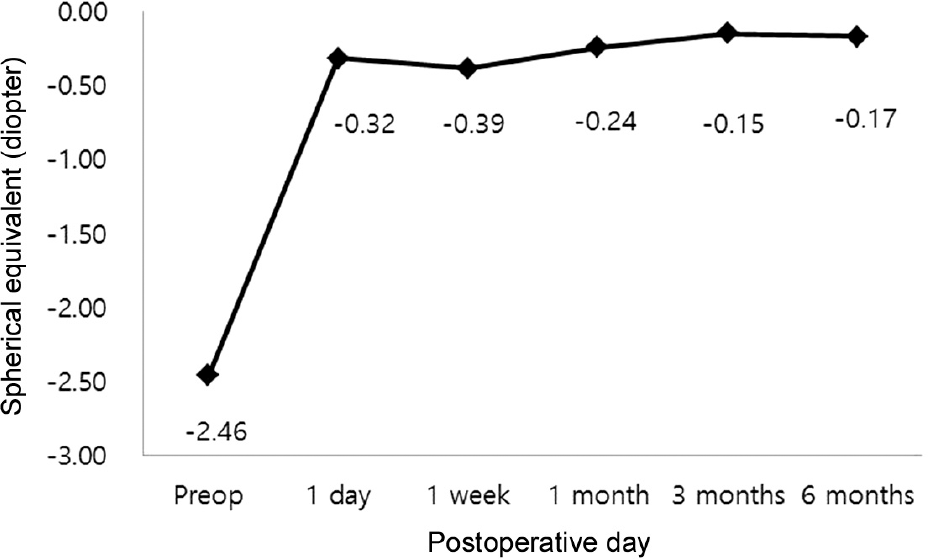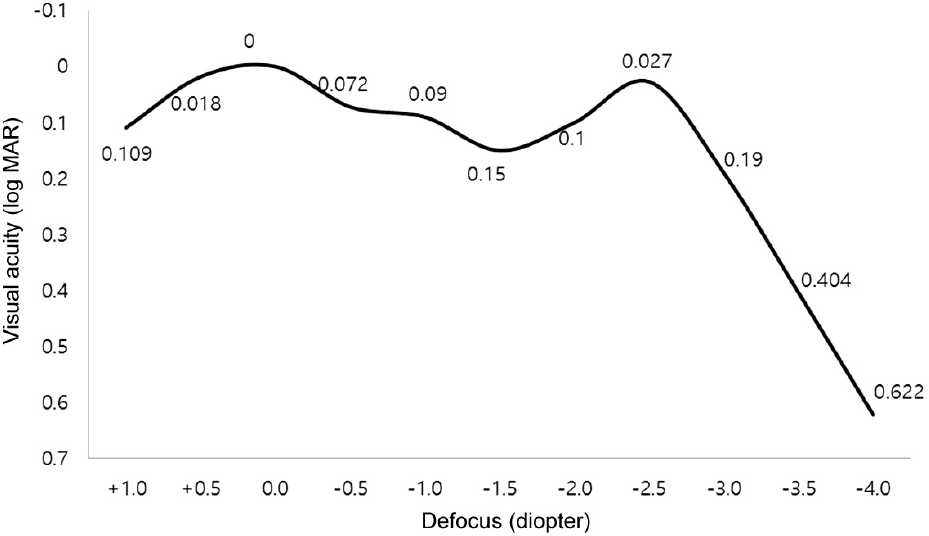Abstract
Purpose
To evaluate clinical outcomes after cataract surgery with bilateral implantation of the diffractive trifocal intraocular lens (IOL).
Methods
Forty-four eyes of 22 patients were analyzed in the present study from July 2014 to December 2014. Phacoemulsification with bilateral implantation of an AT Lisa tri 839 MP IOL (Carl Zeiss Meditec, Jena, Germany) was performed. Over a 6-month fol-low-up, the main outcome measures were uncorrected distance visual acuity (UDVA), uncorrected intermediate visual acuity (UIVA) at 80 cm, uncorrected near visual acuity (UNVA) at 40 cm, and spherical equivalent refraction. Visual quality and patient satisfaction were evaluated using a Quality of Vision questionnaire. Finally, the defocus curve was measured.
Results
The mean monocular UNVA, UIVA, and UDVA were 0.23, 0.22, and 0.02 log MAR at 1 month, 0.21, 0.20, and 0.01 log MAR at 3 months and 0.20, 0.22, and 0.01 log MAR at 6 months postoperatively, respectively. The mean binocular UNVA, UIVA, and UDVA were 0.16, 0.12, and 0.0 log MAR at 1 month, 0.15, 0.11, and 0.0 log MAR at 3 months and 0.15, 0.13, and 0.0 log MAR at 6 months postoperatively, respectively. Twelve patients reported glare and 17 patients reported halo. Defocus curve showed best visual acuity results at 0.0 D and second peak at - 2.5 D. The intermediate-vision values were stable.
References
1. Blaylock JF, Si Z, Vickers C. Visual and refractive status at differ-ent focal distances after implantation of the ReSTOR multifocal in-traocular lens. J Cataract Refract Surg. 2006; 32:1464–73.

2. de Vries NE, Nuijts RM. Multifocal intraocular lenses in cataract surgery: literature review of benefits and side effects. J Cataract Refract Surg. 2013; 39:268–78.

3. Mester U, Hunold W, Wesendahl T, Kaymak H. Functional out-comes after implantation of Tecnis ZM900 and Array SA40 multi-focal intraocular lenses. J Cataract Refract Surg. 2007; 33:1033–40.

4. Woodward MA, Randleman JB, Stulting RD. Dissatisfaction after multifocal intraocular lens implantation. J Cataract Refract Surg. 2009; 35:992–7.

5. Lee HS, Park SH, Kim MS. Clinical results and some problems of multifocal apodized diffractive intraocular lens implantation. J Korean Ophthalmol Soc. 2008; 49:1235–41.

6. Retzlaff JA, Sanders DR, Kraff MC. Development of the SRK/T intraocular lens implant power calculation formula. J Cataract Refract Surg. 1990; 16:333–40.

7. John Shammas H. Intraocular lens power calculations, 1st ed. New Jersey: Slack Inc.,. 2003; 41–57.
8. McAlinden C, Pesudovs K, Moore JE. The development of an in-strument to measure quality of vision: the Quality of Vision (QoV) questionnaire. Invest Ophthalmol Vis Sci. 2010; 51:5537–45.

9. Mojzis P, Peña-García P, Liehneova I. . Outcomes of a new dif-fractive trifocal intraocular lens. J Cataract Refract Surg. 2014; 40:60–9.

10. Law EM, Aggarwal RK, Kasaby H. Clinical outcomes with a new trifocal intraocular lens. Eur J Ophthalmol. 2014; 24:501–8.

11. Marques EF, Ferreira TB. Comparison of visual outcomes of 2 dif-fractive trifocal intraocular lenses. J Cataract Refract Surg. 2015; 41:354–63.

12. Sheppard AL, Shah S, Bhatt U. . Visual outcomes and sub-jective experience after bilateral implantation of a new diffractive trifocal intraocular lens. J Cataract Refract Surg. 2013; 39:343–9.

13. Cochener B, Vryghem J, Rozot P. . Clinical outcomes with a trifocal intraocular lens: a multicenter study. J Refract Surg. 2014; 30:762–8.

Figure 1.
Changes in the spherical equivalent during the fol-low up. Postoperative spherical equivalent ranged from -0.5 D to 0 D at all postoperative visits. D = diopter; Preop = preoperative.

Figure 2.
Postoperative uncorrected visual acuity. (A) Monocular uncorrected visual acuity for distant, intermediate, and near dis-tance during the follow-up. (B) Binocular uncorrected visual acuity for distant, intermediate, and near distance during the follow-up. log MAR = logarithm of the minimum angle of resolution.

Figure 3.
Defocus curve. Defocus curve shows best visual acuity results at 0.0 D and second peak at -2.5D. The inter-mediate-vision values were stable. log MAR = logarithm of the minimum angle of resolution.





 PDF
PDF ePub
ePub Citation
Citation Print
Print


 XML Download
XML Download